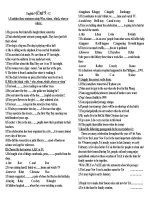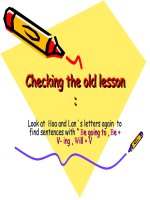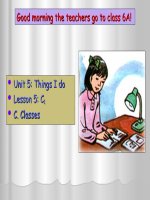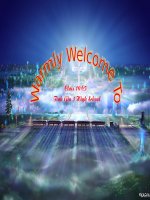UNIT 4
Bạn đang xem bản rút gọn của tài liệu. Xem và tải ngay bản đầy đủ của tài liệu tại đây (1.53 MB, 18 trang )
<span class='text_page_counter'>(1)</span><div class='page_container' data-page=1>
AT THE SUPERMARKET
1. Nick is at the supermarket. He is speaking to his wife, Sarah, on his mobile.
Read and listen to their conversation.
</div>
<span class='text_page_counter'>(2)</span><div class='page_container' data-page=2>
<b>Count nouns </b> <b>unount nouns </b>
A pen
An apple
An egg
A dollar
A cup
Water
Sugar
Milk
Music
money
- Count nouns can be singular or plural.
- Uncount nouns can only be singular.
Much and Many
- We use much with uncount nouns in questions and negatives.
Ex 1: How much money do you have?
Ex2: There isn’t much sugar left.
- We use many with count nouns in questions and negative.
Some/any
o Some is used in positive sentences
Ex: I’d like some sugar.
o -Any is used in questions and negatives
Ex: Is There any sugar in this tea?
o - We use some in questions that are requests or offers
Can I have some cake?
Would you like some tea?
o - The rules are the same for the compounds someone, anything, anybody,
somewhere, etc…
a few and a little
• We use a few with count nouns.
Ex: There are a few cigarettes left, but not many.
• We use a little with uncount nouns
</div>
<span class='text_page_counter'>(3)</span><div class='page_container' data-page=3>
• We use a lot of/ lots of with both count and uncount nouns
Ex 1: There’s a lot of butter
Ex 2: I’ve got lots of friends.
• A lot of/ lots of can be used in,possitive questions and negatives.
Ex 1: Are there a lot of tourists in your country?
Ex 2: There isn’t a lot of butter, but there’s enough.
2. Match the quantities with the other items on Nick’s shopping list.
3. Continue the conversation with a partner. Use the quantities with the other
items on the list.
</div>
<span class='text_page_counter'>(4)</span><div class='page_container' data-page=4>
PRACTICE
1. Complete the sentences with some or any.
2. Complete the sentences with much or many.
</div>
<span class='text_page_counter'>(5)</span><div class='page_container' data-page=5>
4. Look at the picture. What things can you see?
</div>
<span class='text_page_counter'>(6)</span><div class='page_container' data-page=6></div>
<span class='text_page_counter'>(7)</span><div class='page_container' data-page=7>
THE AMAZING WORLD OF eBAY.
Answer:
The jet cost $4.9 million and the football cost 18,500
2. 125 million use eBay everyday.
</div>
<span class='text_page_counter'>(8)</span><div class='page_container' data-page=8>
4. In 1995. He wanted to create a website for everybody to buy and sell things.
GRAMMAR
<b>Articles: a/an and the </b>
<b>Infinite article: “a” or “an” is used : </b>
• with singular, countable nouns to refer to a thing or an idea for the first time.
– We have a cat and a dog.
• with professions.
– I’m a teacher
– She’s an architect.
• with some expression of quantity: a pair of, a little, a couple of, a few.
<b>• in exclamations with what + a + (adj) + count noun </b>
– What a lovely day!
– What a pity!
<i><b>Definite article: “The” is used : </b></i>
• with singular or plural, countable and uncountable nouns when both the speaker
and the listener know the thing or ideal already.
– We have a cat and a dog. The cat is old but the dog is just a puppy.
– I’m going to the supermarket. Do you want anything? (We both know
which supermarket.)
• Before seas, rivers, hotels, pubs, theatres, museums, and newspapers.
– the Atlantic, the British Museum, the Times
• If there is only one of something.
– the sun, the Queen, the government.
• with the superlative adjectives
– He is the richest man in the world.
<b>No article: There is no article before: </b>
• plural and uncountable nouns when talking about things in general.
– I like potatoes.
– Milk is good for you.
• countries, towns, streets, languages, magazines, meals, airports, and stations.
– I have lunch with John.
</div>
<span class='text_page_counter'>(9)</span><div class='page_container' data-page=9>
– at home in/ to bed at/ to work at/ to school/ university by bus/ by
plane by car by train on foot
– She goes to work by bus.
PRACTICE
1. Complete the sentences with a/an, the, or nothing.
2. Listen to three people talking about what they bought on ebay. Complete the
chart.
<b>Linda </b> <b>Megan </b> <b>Charlie </b>
What cooker shoes car
How much 100 2 1,000
Like or not yes yes Not now
Use often? yes yes Yes, but he’s not
</div>
<span class='text_page_counter'>(10)</span><div class='page_container' data-page=10>
3. Work with a partner. Find one mistake in each sentence.
Answer:
1. a postman
2. Love (not the love)
3. By bus
4. One => a
5. a => the
6. In the centre
7. a lovely house
8. eat bread
<i>4. Make two sentences, one with the definite article the and one without, using </i>
the words in the box.
</div>
<span class='text_page_counter'>(11)</span><div class='page_container' data-page=11></div>
<span class='text_page_counter'>(12)</span><div class='page_container' data-page=12>
1. Look at the pictures and discuss the questions.
1. What is the difference between a shopping centre and a market?
2. Do you ever go shopping in markets? Where?
3. Is there a market where you live? What can you buy there? Can you
bargain for things?
2. Read the information to an article about three markets in very different parts
of the world. Why are markets more interesting than shopping centres?
3. Read the article.
4. Answer the questions:
• Bangkok:
1. It is in a small town called Isle- sur-la- Sorgue, in Southern, France.
1. It is on the canals around the town of Damonen Saduak.
2. It’s open every day from 6.30 .
3. It sells tropical fruit and vegetables, fresh coconut juice, hot soup,
and local food
4. It sells traditional hats, silk dresses, flowered shirts.
5. There are old ladies with huge hats, and food sellers with cookers on their
boats.
6. The market is colorful, noisy, fascinating.
7. We can continue along the canal to the canal villages.
8. Bangkok is the city of the contrasts- tall glass buildings and the 100- year-
old canals.
• Provence:
1. It is in a small town called Isle- sur-la- Sorgue, in Southern, France.
2. It’s open every Sunday from early morning until 1 o’clock.
3. It sells olives, cheese, roast chicken, herb, olives bread, tomatoes, ham,
melon.
4. It sells antique French furniture, antique lace and cloth, flowers, soap,
lavender, sun hats, beach towels, local rose wine.
</div>
<span class='text_page_counter'>(13)</span><div class='page_container' data-page=13>
6. The market is truly amazing, packed, noisy, busy, beautiful, brightly
colored.
7. We can find a cool place next to the river for a picnic.
8. It’s a sleepy little town, with narrow streets and many bridges like Venice.
• Marrakech:
1. It’s behind the main square in Marrakech, Jemaa el Fna.
2. It’s open from early morning until lunchtime, and again in the evening.
3. It sells spices and meat
4. It sells clothing, gold, silver, carpets and rugs.
5. Mr Youssaf invites you to sit down and gives you tea and talks for hours
about his rugs.
6. The market is narrow, busy, aromatic, noisy, colourful, beautiful.
7. After the market, we can return to the main square, and watch the snakes
(and count money)
8. It looks like a Hollywood film set. A city of ancient, sand-coloured buildings
and palm trees in the middle of the desert.
5. Write a postcad
VOCABULARY, LISTENING, AND SPEAKING
Shopping
</div>
<span class='text_page_counter'>(14)</span><div class='page_container' data-page=14>
2. Complete the table with the things in the box.
3. Listen to the four conversations. Answer the questions about each one.
• Conversation 1
1. In a café
2. A coffee and a doughnut
3. Yes
</div>
<span class='text_page_counter'>(15)</span><div class='page_container' data-page=15>
• Conversation 2
1. A chemist’s
2. Something for a bad cold and a sore throat
3. Yes
4. Aspirin and tissues
• Conversation 3 (first part)
1. A clothes shop
2. Nothing, just looking
3. No
4. Nothing
Conversation 3: (Second part)
1. A clothes shop
2. A brown jacket
3. Yes
4. A brown jacket
• Conversation 4
1. A post office
2. To send a parcel
3. Yes
4. Stamps to send the parcel, a book of first class stamps
4. Do you often go shopping? What do you like going shopping for?
What don’t you like going shopping for?
5. Work in small groups. Make a list of the different shops in your area and what they
sell. Talk about the different shops.
EVERYDAY ENGLISH
Prices
</div>
<span class='text_page_counter'>(16)</span><div class='page_container' data-page=16>
2. In your country, how much is …?
</div>
<span class='text_page_counter'>(17)</span><div class='page_container' data-page=17></div>
<span class='text_page_counter'>(18)</span><div class='page_container' data-page=18></div>
<!--links-->









